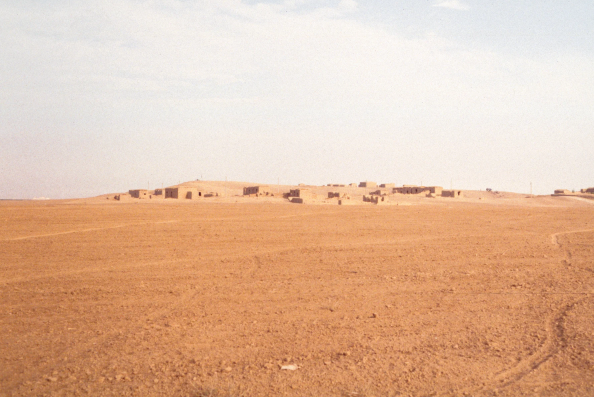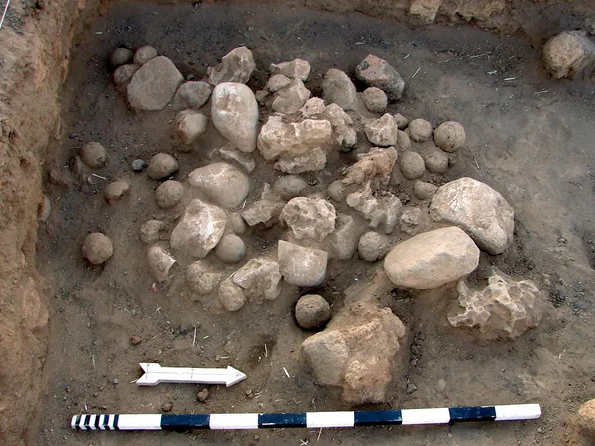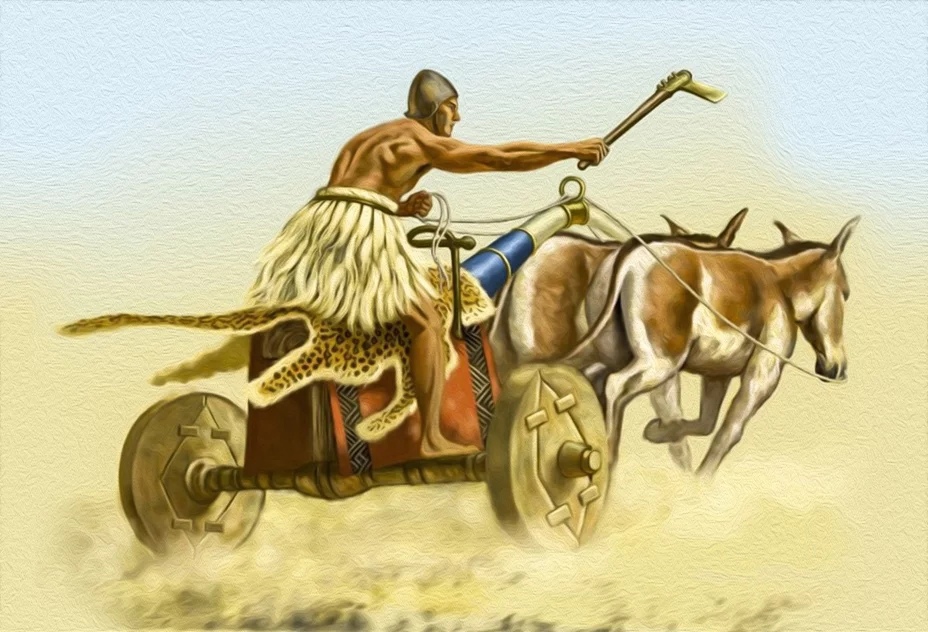It is likely that the first war in human history took place about five and a half thousand years ago. At that time, the city of Hamukar was wiped off the face of the earth. In 2006, traces of the once flourishing city were discovered on the territory that is the border between Syria and Iraq. The findings allow us to draw some conclusions about the tragedy that played out in the distant past in the city of Hamukare.

Apparently, the city could not be defended. Such a circumstance was well understood by the inhabitants of the city. A hail of stones was pouring down on the doomed Hamukar. Despite this, the defenders of the city continued to fight back. For example, a vat filled with water, which was buried in the ground, served as a place for the defenders to soak lumps of clay in order to use them in their slingshot attacks on the heads of the attackers. About a thousand such clay projectiles have been discovered. However, the city was doomed. Hamukaru’s fortune did not smile…. The attackers used fire. They didn’t even need to fight, as the roofs and walls of the dwellings that served as the last «fortress» of the defenders simply collapsed, killing people alive under their rubble.

Archaeologists have been excavating Hamukar since 1999. The ancient settlement is located in northeastern Syria and is a few kilometers from the border, as we mentioned earlier. What’s interesting is that many of Hamukar’s houses were not collapsed. Okay, so… Maybe the war wasn’t the cause of Hamukar’s demise. An earthquake, perhaps? No, an earthquake can’t be the cause of Hamukar’s disaster. Shells were scattered everywhere, charred walls of dwellings were seen, extensive devastation was discovered…. All the findings indicated that the city had been attacked. No, it wasn’t. The city was not just the target of the attackers, it was the scene of a great and bloody battle! The researchers of the question believe that the invaders were foreigners living in the southern and fertile regions of Mesopotamia (quite probably from Uruk — the most powerful ancient city of that period).
Hamukar was not just attacked by bandits. He was the victim of a host of warriors who had in their arsenal terrible firepower. No mention of this war remains. No odes or tales have been dedicated to it. However, an involuntary monument, which confirm its reality, are loads of huge balls lying on the ground. These were the first findings of Hamukar’s explorers. The same findings became the basis for various hypotheses about what happened.
What is known about when, in fact, Hamukar was built? The opinions of researchers vary. However, we can say that at this place about 6000-6500 years ago, the inhabitants processed obsidian (in other words — volcanic glass). Volcanic glass or obsidian is a valuable ornamental metal, which was used to make weapons in ancient times (yes, yes, right up to the time when man learned to work metal). Nevertheless, it is interesting to note that obsidian was not mined in the vicinity of Hamukar! Its nearest deposits were many kilometers away from the city (the area of modern Turkey).

So how did obsidian end up in Hamukar? It is quite likely that the inhabitants of Hamukar bought obsidian, from which they later learned to forge goods. C. Reichel, an archaeologist at the University of Chicago and also the head of the excavations, states that we should imagine the inhabitants as «quasi-industrial producers» of weapons or tools.
It is believed that people who only recently walked with a plow or herded cattle preferred to move to Hamukar. They learned to craft, trade and, as a consequence, become rich and prosperous.
«And once people have wealth, they build walls to protect themselves and their possessions. So in the middle of a field a fenced fortress-city is born.» K. Reichel on the history of Hamukar.
Soon Hamukar became a prosperous and affluent metropolis, which naturally aroused envy and anger from its neighbors and the inhabitants of various cities.
It is known that the central square of Hamukar spread over 16 hectares. It was surrounded by a huge (about three meters) wall. Around the square there were settlements of craftsmen.
When, in fact, was Hamukar destroyed? And under what circumstances? It is believed that the city was destroyed when the «age of volcanic glass» was over. It is assumed that the inhabitants of Hamukar began to trade in copper, having caught the «fashionable trend».
At the beginning of the IV millennium BC, a kind of «cultural revolution» takes place in Mesopotamia. And it is worth saying that the progress of technological development, which was at that time the inhabitants of Mesopotamia, can well be compared with the technological revolutions of our century! What happened? Well, firstly, the wheel appears, which developed transportation, secondly, the potter’s wheel was invented, and soon cities began to grow.
More recently, it was believed that Southern Mesopotamia is the cradle of civilization of mankind. However, excavations in Hamukar make us think about this statement, because, according to the archaeologist of the University of California G. Olgeiz, the existence of such cities as Hamukar or Tell Brak, for example, on the territory of modern Syria, indicates that the first cities appeared in the south and in the north of Mesopotamia. And, interestingly enough, apparently independently of each other. Recall that previously it was believed that Northern Mesopotamia «dressed» with cities only under the influence of its southern «sister».

It is likely that the first war in the history of mankind took place about five and a half thousand years ago. Then the city of Hamukar was wiped off the face of the earth. In 2006, traces of the once flourishing city were discovered on the territory that is the border between Syria and Iraq. The findings allow some conclusions to be drawn about the tragedy that played out in the distant past in the city of Hamukar.
Apparently, the city could not be defended. Such a circumstance was well understood by the inhabitants of the city. A hail of stones was pouring down on the doomed Hamukar. Despite this, the defenders of the city continued to fight back. For example, a vat filled with water, which was buried in the ground, served as a place for the defenders to soak lumps of clay in order to use them in their slingshot attacks on the heads of the attackers. About a thousand such clay projectiles have been discovered. However, the city was doomed. Hamukaru’s fortune did not smile…. The attackers used fire. They did not even need to fight, as the roofs and walls of the dwellings, which served as the last «fortress» of the defenders, simply collapsed, killing people alive under their rubble.
Archaeologists have been excavating Hamukar since 1999. The ancient settlement is located in northeastern Syria and is a few kilometers from the border, as we mentioned earlier. What’s interesting is that many of Hamukar’s houses were not collapsed. Okay, so… Maybe the war wasn’t the cause of Hamukar’s demise. An earthquake, perhaps? No, an earthquake can’t be the cause of Hamukar’s disaster. Shells were scattered everywhere, charred walls of dwellings were seen, extensive devastation was discovered…. All the findings indicated that the city had been attacked. No, it wasn’t. The city was not just the target of the attackers, it was the scene of a great and bloody battle! The researchers of the question believe that the invaders were foreigners living in the southern and fertile regions of Mesopotamia (quite probably from Uruk — the most powerful ancient city of that period).
Hamukar was not just attacked by bandits. He was the victim of a host of warriors who had in their arsenal terrible firepower. No mention of this war remains. No odes or tales have been dedicated to it. However, an involuntary monument, which confirm its reality, are loads of huge balls lying on the ground. These were the first findings of Hamukar’s explorers. The same findings became the basis for various hypotheses about what happened.
What is known about when, in fact, Hamukar was built? The opinions of researchers vary. However, we can say that at this place about 6000-6500 years ago, the inhabitants processed obsidian (in other words — volcanic glass). Volcanic glass or obsidian is a valuable ornamental metal, which was used to make weapons in ancient times (yes, yes, right up to the time when man learned to work metal). Nevertheless, it is interesting to note that obsidian was not mined in the vicinity of Hamukar! Its nearest deposits were many kilometers away from the city (the area of modern Turkey).
So how did obsidian end up in Hamukar? It is quite likely that the inhabitants of Hamukar bought obsidian, from which they later learned to forge goods. C. Reichel, an archaeologist at the University of Chicago and also the head of the excavations, states that we should imagine the inhabitants as «quasi-industrial producers» of weapons or tools.
It is believed that people who only recently walked with a plow or herded cattle preferred to move to Hamukar. They learned to craft, trade and, as a consequence, become rich and prosperous.
«And as soon as people have wealth, they build walls to protect themselves and their possessions. So in the middle of a field, a walled fortress-city is born.» K. Reichel on the history of Hamukar.
Soon Hamukar became a prosperous and affluent metropolis, which naturally aroused envy and anger from its neighbors and the inhabitants of various cities.
It is known that the central square of Hamukar spread over 16 hectares. It was surrounded by a huge (about three meters) wall. Around the square there were settlements of craftsmen.
When, in fact, was Hamukar destroyed? And under what circumstances? It is believed that the city was destroyed when the «age of volcanic glass» was over. It is assumed that the inhabitants of Hamukar began to trade in copper, having caught the «fashionable trend».
At the beginning of the IV millennium BC in Mesopotamia there is a kind of «cultural revolution». And it is worth saying that the progress of technological development, which was at that time the inhabitants of Mesopotamia, can well be compared with the technological revolutions of our century! What happened? Well, firstly, the wheel appears, which developed transportation, secondly, the potter’s wheel was invented, and soon cities began to grow.
More recently, it was believed that Southern Mesopotamia is the cradle of civilization of mankind. However, excavations in Hamukar make us think about this statement, because, according to the archaeologist of the University of California G. Olgeiz, the existence of such cities as Hamukar or Tell Brak, for example, on the territory of modern Syria, indicates that the first cities appeared in the south and in the north of Mesopotamia. And, interestingly enough, apparently independently of each other. Recall that earlier it was believed that Northern Mesopotamia «dressed» with cities only under the influence of its southern «sister».
Could it be that the civilization of Northern Mesopotamia is somehow different from that of the South? Yes, of course. Their development was somewhat different. Archaeologists are quite surprised that Hamukar could exist at all. It is worth saying that the city was located far from the rivers, on the border of the Tigris and Euphrates watershed. The rulers were not interested in irrigation works, but in trade transactions. In Southern Mesopotamia, on the other hand, the inhabitants were concerned with irrigation work (farming). Thus, what do we see? In the north of Mesopotamia — trade and craft, and in the south — agriculture.
In the battle of the two cultures, the south won. The rich cities of the trading north were plundered, destroyed, burned. Their culture was lost.

The work of archaeologists in the area of Hamukar allows us to conclude that the city was extremely important. And because of its importance, war became something inevitable. The attack on Hamukar was methodical and brave. The invaders needed obsidian, metal ore, cedar wood and so on. Hamukar had it all. And as a result — a forgotten, destroyed, dead city, hidden for a long time from the eyes of people and researchers.
